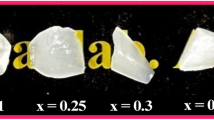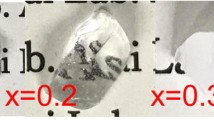Abstract
Here we describe luminescent and scintillation properties of glasses of stoichiometric compositions: MO–SiO2 and MO–SiO2–Gd2O3 (M = Ca, Ba). It was shown that photo-excited luminescence spectra are systematically shifted to the long wavelength range in a comparison with radio-excited luminescence spectra. It shows that only a fraction of Ce ions took part in the creation of scintillation in the glass.
Access provided by CONRICYT-eBooks. Download conference paper PDF
Similar content being viewed by others
Keywords
- Gd 2O
- Photo-luminescence Spectra
- Radio Luminescence (RL)
- Low Melting Temperature Glass
- Ternary Silicate Glasses
These keywords were added by machine and not by the authors. This process is experimental and the keywords may be updated as the learning algorithm improves.
1 Introduction
There is a variety of inorganic scintillating materials which find applications as ionizing radiation detectors in medical imaging, security, geological exploration, high-energy physics, nuclear instrumentation etc. [1,2,3]. Most of these materials are used in single crystal or ceramic forms. Also glasses attracted the attention of researchers due to their combination of unique properties; they are in fact cheap to produce, environmentally friendly, transparent, and can be easily obtained in different forms: from bulks to fibers. With respect to crystalline compounds, glasses are also characterized by a lower concentration quenching [4] of the rare earth ions luminescence. However, the disordered structure of the atoms in glasses and the presence of the structural defects are the cause of low efficiency in the transfer of electronic excitation to emitting centers, thus preventing the achievement of high scintillation yields when the glasses are doped with suitable luminescence ions, like for instance Ce3+. So far, encouraging results have been obtained with Ce-doped sol-gel SiO2 [5, 6].
Among glasses, silicates look to be the most interesting in order to obtain new scintillation materials. Indeed, silica is a good glass forming compound, and crystalline silicates (notably oxyorthosilicates and pyrosilicates) already find numerous application as scintillating materials [7, 8].
It should be noted, however, that doping of pure silica glass with rare earth (RE) ions by using a standard melting method is a difficult task: the large difference in ionic radii, and the different coordination numbers of RE and Si ions result in difficult incorporation of RE ions in the silica matrix and a general tendency to RE segregation. Moreover, RE doping can also result in the formation of defects acting as traps for free carriers in the silica matrix. These difficulties have been solved by using the sol-gel method to synthesize glasses with low RE contents, or by modifying the glass structure with the addition of other elements. Alkaline earth silicates are, in this respect, particularly attractive, since glasses with stoichiometric compositions can be obtained, leading to a lower probability of defect creation and higher radiation hardness. However, our studies shown that the scintillation properties of these binary glasses strongly depend on which alkali-earth cation is used.
In this paper we report comparisons among radio- and photo-luminescence spectra for a series of binary and ternary silicate glasses. We found that photo-excited luminescence spectra are systematically red-shifted with respect to the radioluminescence ones. This suggests that only a fraction of Ce ions takes part in the scintillation light emissions in these glasses.
2 Materials and Methods
2.1 Glasses Synthesis
MO–SiO2 and CaO–SiO2–Gd2O3 glasses doped with Ce3+ ions were obtained by heat treatment of a mixture of MCO3 (M = Ba, Ca), SiO2, Gd2O3, and CeO2. CeO2 was introduced by substitution of 1 at% of M2+ ions in glasses. The ratio MO:SiO2 in glasses was 1:2, while for CaO–SiO2–Gd2O3 glasses the components ratio was close to 1:2:0.34. The raw materials with 99.99% purity were weighed and homogenized in 20 cm3 aluminum oxide ceramic crucible. The synthesis of the binary glasses was performed at 1450 °C in a gas furnace in a high concentration CO atmosphere for 2 h. The obtained bulk glasses were annealed at 500 °C for 4 h in a muffle furnace to reduce the stress. The ternary glasses have been obtained in a similar way but heating the raw materials at 1550 °C for 3 h and annealing at 600 °C for 4 h. The obtained glass blocks were colorless. Samples for the optical study were cut from the initial block in 1 mm thick plates and finished to an optical grade.
2.2 Samples Measurements
X-ray excited radio-luminescence (RL) measurements were carried out at room temperature with an apparatus featuring a CCD detector (Jobin-Yvon Spectrum One 3000) coupled to a monochromator (Jobin-Yvon Triax 180) with a 100 grooves/mm grating and covering the 200–1100 nm wavelength range. The excitation was performed with a Philips 2274 X-ray tube set at 20 kV and 20 mA. All X-ray irradiations were carried out in the same conditions with variable exposition time.
Steady state photoluminescence (PL) spectra were obtained at RT using a xenon lamp as excitation source coupled to a Jobin-Yvon Gemini 180 double monochromator, and recorded with a nitrogen-cooled CCD detector coupled to a monochromator Jobin-Yvon Micro HR.
3 Glass Forming in MO–SiO2 (M = Ca, Ba) Systems
Among two-component systems, the MO–SiO2 (where M = Ba, Ca) system has the most extensive glass forming region. This is seen from Fig. 1, which shows the diagram of states in the BaO–SiO2 system.
Phase diagram of BaO–SiO2 system [9]
A number of various compounds and eutectics forms exist in the system BaO–SiO2 in a stable equilibrium [9]. It was found that stable stoichiometric compositions BaO–SiO2 (BS); 2BaO–SiO2 (B2S), 2BaO–3SiO2 (B2S3) and BaO–2SiO2 (BS2) with melting point 1604, 1700, 1450 and 1420 °C are formed. Even though the melting temperatures of these compounds are comparable to each other, the BaO–2SiO2 composition is preferable because of its lowest temperature melting glass. In the case of CaO–SiO2 system, there are also four stoichiometric compositions: CaO–SiO2 (1544 °C); 2CaO–SiO2 (2130 °C), 3CaO–2SiO2 (1464 °C) and 3CaO–SiO2 (2070 °C). Upper limit of vitrification is 50 mol% of CaO. The most interesting compositions are in the area of the eutectic with melting point of 1435 °C that is close to the composition CaO–2SiO2.
4 Results and Discussion
BaO–2SiO2 (DSB) glass and glass ceramics are well known scintillating materials [10]. It worth to note that the scintillation time decay of DSB:Ce glass is not particularly sensitive to the Ce3+ concentration until concentration quenching begins. The time decay can be well approximated using a sum of three exponential components. The decay is in fact composed by a fast 30 ns decay (~40% of total weight), an intermediate one (~50% of total weight) of about 180 ns, and 10%-component having decay constant in the range 250–350 ns. The presence of this slowest component in the scintillations depends both on Ce3+ concentration and on Ba/Si ratio in the matrix composition. The light yield of DSB:Ce sample with 662 keV 137Cs gamma-source was found to be of the order of 100 photo-lectrons per MeV, in good agreement with previous results [10]. An increase of Ce content in the glass does not result in a proportional increase in the light yield of the material. One of the possible explanation is the Ce stabilization not only in a trivalent state, but also in tetravalent state in the glass, when the activator concentration reaches values of more than a few atom percents.
Contrary to BaO–2SiO2, the calcium-silicate glass practically does not show any scintillation. However, the introduction of Gd2O3 in the glass composition dramatically increases radio-luminescence intensity, as clearly visible in Fig. 2. In pure binary system, the ratio between SiO2 and CaO has been chosen from the point of view of the formation of stoichiometric compound with the lowest melting point in the glass-forming region. The composition of CaO–2SiO2–0.34Gd2O3 glass was found experimentally. A further increase in the Gd2O3 quantity leads to a rapid increase of glass melting temperature. As it can be seen from the spectra in Fig. 2, the Gd3+ luminescence is clearly visible at 313 nm, thus suggesting that Ce3+ luminescence sensitization through the Gd3+ subsystem is not completely effective.
Figures 3, 4 and 5 report comparisons between the normalized photoluminescence (excited in the first Ce3+ 4f-5d transition at 350 nm for all the studied samples) and radio-luminescence spectra of Ba–Si, Ca–Si and Ca–Si–Gd glasses, respectively.
A general difference has been observed between PL and RL spectra. The former are systematically shifted to longer wavelengths with respect to the RL ones. Since there is a series of different sites available for Ce3+ stabilization in the glass due to inhomogeneous broadening, one can rather safely suppose that also the Ce3+ luminescence properties are affected However, it seems that among all Ce3+ ions in the glass, only some fraction of ions, which has favorable conditions to capture free carriers, contribute to the scintillation. Thus, an increase of this fraction in Ce doped glass may be a prospective way for further increase of the glass scintillation yield.
5 Conclusions
Investigation of binary and heavy glasses doped with Gd showed that photo- luminescence spectra are systematically red-shifted with respect to those obtained in radio-luminescence. It seems that among all Ce3+ ions in the glass, only a fraction of ions, which has favorable conditions to capture free carriers, contribute to radio-luminescence. Thus, an increase of this fraction in Ce doped glass may be a interesting strategy to further increase the glass scintillation yield.
References
W. Moses, Current Trends in Scintillator Detectors and Materials. Nucl. Instrum. Methods Phys. Res. Sect. A 487(1–2), 123–128 (2002)
T.K Gupta, Radiation, Ionization, and Detection in Nuclear Medicine Radiation, Ionization, and Detection In Nuclear Medicine. US, 2013, p. 516
G. Blasse, Scintillator materials. Chem. Mater. 6(9), 1465–1475 (1994)
Yannick G. et. al., Spectroscopic properties, concentration quenching, and laser investigations of Yb3+ -doped calcium aluminosilicate glasses. J. Opt. Soc. of Am. B. 28(10), 2510–2517 (2011)
M. Fasoli, A. Vedda, A. Lauria, F. Moretti, E. Rizzelli, N. Chiodini, F. Meinardi, M. Nikl, Effect of reducing sintering atmosphere on Ce-doped sol-gel silica glasses. J. Non-Cryst. Solids 355, 1140 (2009)
A. Vedda, N. Chiodini, D. Di Martino, M. Fasoli, S. Keffer, A. Lauria, M. Martini, F. Moretti, G. Spinolo, M. Nikl, N. Solovieva, G. Brambilla, Ce3+-doped optical fibers for remote radiation dosimetry. Appl. Phys. Lett. 85, 6536 (2004)
D. Pauwels, L. Masson, N. Viana, B. Kahn-Harari A, E.V.D. Van Loef, P. Dorenbos, Van Eijk A novel inorganic scintillator: Lu2Si2O7:Ce3+ (LPS). IEEE Trans. Nucl. Sci. 47(6), 1787–1790 (2000)
A. Benaglia, S. Gundacker, P. Lecoq, M.T. Lucchini, Para A., Pauwels K., Auffray E, Detection of high energy muons with sub-20 ps timing resolution using L(Y)SO crystals and SiPM readout. Nucl. Instr. Methods Phys. Res A 830, 30–35 (2016)
V. Bazarkovsky, N. Kurceva, V. Lapin, N. Toporov, Handbook of the Phase Diagrams of Silicate Systems, 2nd edn. [in Russian]. (Nauka, Leningrad, 1969), p. 822
P. Lecoq, A. Gektin, M. Korzhik, Inorganic Scintillators for detecting Systems. (Springer, Heidelberg, 2017), p. 406
Acknowledgements
The collaboration and research were supported by the H2020 RISE Intelum Project (Grant Agreement 644260). Grant support of Ministry of Science and Education of Russian Federation № 14.W03.31.0004 is also appreciated.
Author information
Authors and Affiliations
Corresponding author
Editor information
Editors and Affiliations
Rights and permissions
Copyright information
© 2017 Springer International Publishing AG
About this paper
Cite this paper
Tratsiak, Y., Fedorov, A., Dosovitskiy, G., Moretti, F., Trusova, E. (2017). MO–SiO2 and MO–SiO2–Gd2O3 (M = Ca, Ba) Scintillation Glasses. In: Korzhik, M., Gektin, A. (eds) Engineering of Scintillation Materials and Radiation Technologies. ISMART 2016. Springer Proceedings in Physics, vol 200. Springer, Cham. https://doi.org/10.1007/978-3-319-68465-9_10
Download citation
DOI: https://doi.org/10.1007/978-3-319-68465-9_10
Published:
Publisher Name: Springer, Cham
Print ISBN: 978-3-319-68464-2
Online ISBN: 978-3-319-68465-9
eBook Packages: Physics and AstronomyPhysics and Astronomy (R0)









